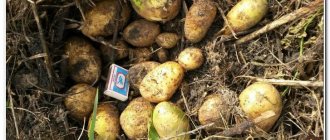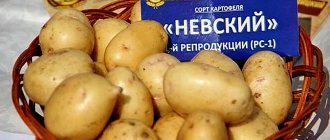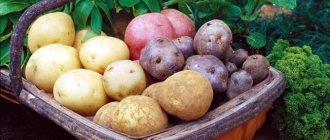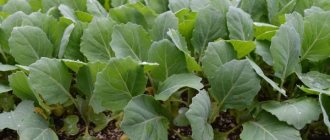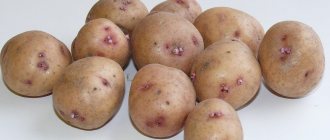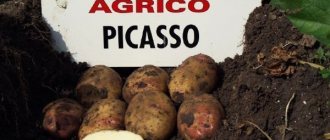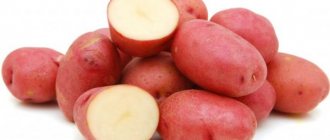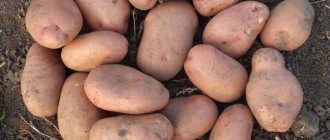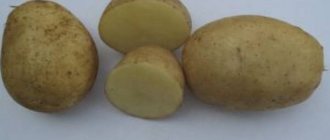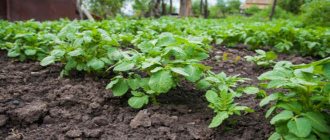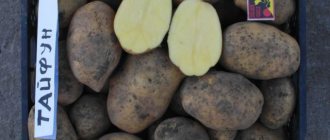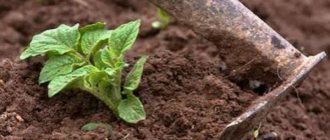It is impossible to unambiguously determine the best potato variety: each type has its own distinctive features. Thus, some varieties are distinguished by their rapid ripening period, others give a better harvest, and others can be stored longer than others. When choosing a potato variety for planting, you should focus on the main criterion, which is the most important for the farmer.
Material content:
- Characteristics of potato varieties
- Seed potato varieties - choose the right ones
- The best potato varieties for the Moscow region
- Popular potato varieties for the middle zone
- Optimal potato varieties for Siberia
- Early potato varieties: photos and descriptions
- Mid-early potato varieties: the best varieties
- Mid-season potato varieties with detailed descriptions
- Mid-late potato varieties: the best of the best
- Late potato varieties: features with illustrations
Potato varieties for the Volga-Vyatka region
For the Volga-Vyatka region, the state register offers about 100 varieties of potatoes zoned for this area. The choice is huge!
Among them are many universal, popular and deservedly loved by gardeners. But there are also new varieties. Among the latest additions are the varieties Crisper, Mondeo, Lad and Volat (characteristics of the varieties are below).
- Kirov region
- Nizhny Novgorod Region
- Perm region
- Mari El Republic
- Sverdlovsk region
- Udmurt republic
- Chuvash Republic
Article on the topic: Potato variety “Azart” - description and photo
Characteristics of potato varieties
When faced for the first time with a huge variety of potato varieties, it is very difficult to understand which of them are intended for consumption and which are optimally suited as food for farm animals. To make this task easier for you, we provide a simplified diagram of the characteristics of varieties.
Common variety varieties
- Canteens . The most common types that have the best taste. Because of this feature, they are commonly used for cooking.
- Technical . These varieties contain a reduced amount of protein, so they are intended for the production of alcohol and starch.
- Feed . By virtue of their name, these varieties are used to feed livestock. They stand out because the level of protein and starch is much higher than normal.
- Universal . These varieties have everything needed to target any of the above tasks.
In addition, potato varieties may differ in the following characteristics: early ripening. Unlike other vegetables, there will be more criteria that cover the duration of fruit ripening.
Varieties of varieties by ripening period
- Early. Fruits appear after 50-65 days.
- Mid-early. Fruits appear after 65-85 days.
- Mid-season. Fruits appear after 85-95 days.
- Mid-late. Fruits appear after 95-110 days.
- Late. Fruit appears after 95 days or more.
Mid-season varieties
The growing period is 112-130 days. Potatoes retain all their characteristics well until spring and have a high yield.
Adretta
Brought out several decades ago in Germany, adapted for cultivation in central Russia. In the State Register since 1980. Potatoes are still the best in terms of taste, the amount of starch is up to 18%. When cooked it has a crumbly structure. From one hundred square meters the yield reaches 450 kg.
The tubers have a long shelf life, even after freezing, the potatoes do not acquire a sweetish taste. The species is resistant to cancer and viruses, and is not affected by scab, late blight, or rhizoctonia.
Adretta potatoes
Advantages:
- high taste qualities;
- adaptability to any weather conditions;
- good keeping quality.
Flaws:
- affected by certain diseases.
Nevsky
The variety was developed by scientists at the Leningrad Research Institute of Agriculture in the 70s of the last century. Until now, potatoes are not inferior to the quality characteristics of new breeding products. Nevsky is high-yielding - up to 600 kg per hundred square meters. The crop can be grown in any region, it is not picky about the soil, and it is drought-resistant. On hot days, the leaves of the plant are rolled into a tube to retain moisture. Nevsky almost never gets sick. The skin of the tubers is light yellow with small eyes and white flesh. Full ripening period: 70-85 days.
When cooked, the tubers do not become soft, and the peeled ones do not darken, as they have a low starch content. Nevsky is stored for a long time, is resistant to rhizoctoniozone, and to late blight - moderate perception.
Nevsky potatoes
Advantages:
- high yield;
- drought resistance;
- raw, peeled potatoes do not darken;
- not sick.
Flaws:
- rapid germination of eyes.
Aurora
Russian variety, in the State Register since 2006. The popular name is “red-eye”. Productivity from one hundred square meters to 400 kg. After 3 months, the first root crops ripen. The skin of the tubers is pink-brown, the flesh is creamy. The culture is unpretentious to any changes in weather conditions.
Root vegetables with good taste, suitable for purees, smooth, easy to clean, the eyes are barely noticeable, and there are few of them. The harvest is well stored until spring.
Aurora potatoes
Advantages:
- excellent taste;
- drought resistant;
- not susceptible to disease.
Flaws:
- No.
Tuleevsky
The potato variety was created at the Kemerovo Research Institute and named after Aman Tuleyev. In the State Register since 2006. Zoned for planting in the Volga-Vyatka, Far Eastern regions and regions of Siberia. Full maturity occurs on day 110. With high-quality care, up to 400 kg can be collected from one hundred square meters. The root vegetables are sandy in color, have an excellent taste and are used to prepare various dishes. Contains 15% starch.
Tuleyevsky has a stable immunity to diseases. Not picky about soil type. Keeping quality up to 90%.
Tuleyevsky potatoes
Advantages:
- high yield;
- not demanding on climatic and soil conditions;
- excellent taste;
- long-term storage.
Flaws:
- susceptible to nematode.
Seed potato varieties - choose the right ones
It is worth saying that potatoes have weaker protection against all kinds of pests and infections than other vegetables. If this is not taken into account, the tubers will work solely to survive, and not focus on a good harvest.
The only exceptions can be those varieties that successfully resist many of their varieties. But not all resistant varieties have better taste and large fruit. That is why the choice of varieties must be taken with full responsibility.
It should also be taken into account that after 3-4 years the variety will degenerate, which means that it is necessary to find an appropriate replacement for it. An ideal option would be elite planting material. It will be extremely difficult to grow it yourself, because it is a very long and intensive process that requires specific conditions.
When purchasing it, it would not be superfluous to ask the seller about the quality certificate. This is relevant due to the fact that very often sellers can offer ordinary potatoes instead of the desired elite planting material.
If you do not want the purchased planting material to become unusable too quickly, then it should be dug up before the lion's share of the harvest begins to appear.
As for the characteristics of the varieties, here it is also worth being vigilant not only regarding traditional factors (taste, yield and large-fruited size), but also several others (earliness and the place where it comes from). Compliance with the last factor will help determine the compatibility of the climate zone, which is extremely important when growing potatoes.
Different varieties
When growing potatoes on an industrial scale, its purpose is of no small importance. Varieties are distinguished by their % starch content: table, technical, fodder, universal.
The use of the product depends on the amount of starch content. For frying, it is suitable with less content, and for boiling, vice versa.
Potato varieties are divided according to ripening time:
- early ripening – 70-80 days;
- mid-early – 80-90;
- mid-season – 90-110;
- mid-late – 110-120;
- late – 120-140.
The earliest harvest is obtained in the Krasnodar Territory in late May-early June.
For planting, you should choose high-quality seed material with strong immunity to pests. It is believed that domestically bred varieties have increased resistance to diseases, while imported ones do not suffer from potato nematode.
Varieties resistant to pests and diseases:
- Colorado potato beetle: Garnet, Lasunak, Ogonyok, Temp, Loschinsky, Crystal.
- Nematode: Odysseus, Juliana, Amadeus, Agrius, Sante, Zhukovsky, Latuna.
- Cancer: Lukyanovsky, Adretta, Detkoselsky, Priekulsky.
- Scab: Bryansk novelty, Berlichingen, Detkoselsky.
- Late blight: Gatchinsky, Luck, Lina, Nikulinsky, Olev, Temp.
The best potato varieties for the Moscow region
Many summer residents involved in growing potatoes in the Moscow region have noted that this activity is extremely risky. Due to non-standard climatic conditions and many other factors, when choosing varieties for planting, you should note several important features.
Firstly, varieties must have good protection against pests and diseases. Secondly, you should choose only early, mid-early and mid-ripening varieties. If you go into experiments and take later varieties for planting, they simply will not have time to ripen.
Additionally, you need to pay attention to whether they are intended for planting in the Moscow region. If the selected variety does not have this indicator, but it adapts quite easily to existing conditions, then this point can be skipped.
List of potato varieties
Nevsky
The variety is considered mid-early because the fruit ripening period ranges from 75 to 85 days. The bush can produce up to 15 tubers, each of which will weigh on average 90-140 grams. Average yields per hectare are up to 360 centners.
The variety can be used for various purposes because it is universal. The fruits are characterized by excellent taste and the ability to maintain their appearance for a long time.
Common viral diseases and late blight will not interfere with this variety. However, it will need protection from potato nematode.
Sorcerer
This variety is characterized by several features: early ripening, resistance to drought and late blight, as well as extreme productivity. The fruits can be stored for a long time. Each bush is capable of producing up to 15 tubers. The weight of one tuber can reach 200 grams.
Separately, it is worth noting its protection against potato nematode and scab. Thanks to its distinctive taste characteristics, Charodey is considered one of the most delicious among domestic and foreign varieties.
Lorch
The presented variety is considered late and extremely popular among summer residents. It is considered universal, therefore it can be intended for absolutely any purpose. Taste characteristics, as well as the ability to be stored for a long time without changes, are at a high level. One tuber can weigh 140 grams.
Typically, the shape of the tubers is round-oval, but if there is not enough phosphorus and potassium in the soil, it will become oblong.
Luck
This variety forms tubers quite early, and their quantity will eclipse any ideas about high yields (up to 120 kilograms per bush). The average weight of one tuber is 130 grams. Taste characteristics are above normal. Long-term storage will not affect the external qualities.
Dry periods are not terrible for this variety, but all kinds of pests can significantly weaken it. Among them are late blight, scab and viral infections. When planting, you can pay attention to the quality of the soil, because the variety adapts perfectly to existing conditions.
Sineglazka
This variety is considered a mid-early variety, which can surprise with a rich harvest and excellent taste. Long-term storage in small volumes will be possible for fruits without any problems. If you do not take this fact into account, then the external characteristics will be significantly underestimated.
It is worth mentioning separately about resistance to common infections and diseases. Due to its table type, its main purpose is cooking.
The best varieties for shelf life
The possible shelf life of the crop is another valuable criterion for choosing a potato variety, since it is grown in large quantities so that the vegetable lasts for a long time - from autumn to spring.
Potato varieties with late ripening periods are best suited for storing tubers in winter. This:
- Crane. Tubers ripen 130 days after planting. Potatoes of this variety have a good taste and, with proper storage conditions, can be used for preparing any first or second courses. During the winter period, Zhuravinka potatoes do not get sick or rot.
- Stonefly. These potatoes can be planted on any soil, as they grow and develop even in the absence of rain in summer. It tolerates winter storage without problems.
- Asterix. This mid-late variety is suitable for frying, deep-frying, and making chips. The vegetable is stored for a long time, is resistant to mechanical damage, and is transported over long distances without affecting the appearance of the tubers.
variety Zhuravinka
Vesnyanka variety
variety Asterix
But the right variety is not everything. To ensure a long shelf life for potatoes, it is important to prepare in advance for the harvest a well-ventilated room in which the temperature will be maintained between +5 and +6 degrees. Under these conditions, potatoes can be stored for six months.
If you store tubers at a temperature lower than +5 degrees, then the process of converting starch into sugar starts in them, and this worsens the taste and negatively affects the appearance of the potato.
The cellar with the potato harvest must be dry. Tubers must be placed in wooden containers.
Potato varieties are classified according to different criteria. You can choose a variety that will be the best option for a particular region in terms of yield, resistance to pests, ripening time, and storage duration. Before choosing a specific variety, you need to decide on the main selection criterion and build on it.
2
1
Copy link
Popular potato varieties for the middle zone
The climate in central Russia is temperate, so for successful potato cultivation it is necessary to select varieties that can be successfully grown under existing conditions. The main criterion is early maturity. Otherwise, the potatoes may not have time to produce a decent level of yield.
List of potato varieties
Rocco
One of the most productive varieties, which also successfully resists late blight and Y and Yn viruses. Moreover, sudden drought and the machinations of potato cancer are not scary for him. The tubers turn out to be quite large and capable of both long-term transportation and long-term storage.
On average, one tuber weighs up to 120 grams. The number of tubers from one bush exceeds 12 pieces. Due to their delicious taste, the tubers can be used for a variety of purposes, including cooking and feeding livestock.
Slav
A mid-season variety that is distinguished by fairly high taste qualities and is ready to please the summer resident with incredible yield indicators (more than 500 centners per hectare). The fruits are extremely large and oblong-oval in shape.
Excellent protection against phenomena such as nematodes, cancer and viral infection. In addition, the variety copes well with late blight. Although it does not require high soil quality, the amount of fertilizer required should be increased, taking into account its intensity.
During long-term and careless transportation, potatoes may be damaged, but at rest they will remain without any changes.
Kiwi
Mid-season variety with a decent yield level. It has reliable protection against the Colorado potato beetle, wireworm, as well as many infections and diseases. A separate advantage is the ability of the variety to quickly adapt to existing conditions, so caring for the bush will be greatly simplified.
Adretta
Here is a foreign mid-season variety that boasts several advantages. Excellent taste characteristics, good protection against many infections and diseases, as well as excellent yield. One bush produces an average of 10 tubers.
If climatic conditions change, the variety will perform well without sacrificing a high degree of yield. Tubers can be stored for a long time, including in the winter season.
Rosara
This foreign variety is considered one of the early ones, the tubers of which ripen after 65-70 days. It is especially popular among farmers who grow potatoes for sale. Productivity reaches 300 centners per hectare.
The variety has optimal conditions for long-term storage and transportation. Excellent protection against potato nematode, potato cancer, late blight and scab. Relatively resistant to the Y virus, but has a better chance of coping with the Yn virus.
The hardiest varieties
There are very few rich fertile soils in central Russia. Here there are some that are completely unsuitable for growing any kind of vegetation. Varieties have been created specifically for such lands, allowing a harvest of 50 to 100 kg per hundred square meters.
- Adretta is a universal variety of German selection, drought-resistant and does not require fertilizing. It can grow well in both clay and sandy soils. With regular and abundant watering, a maximum yield of 250 kg per hundred square meters is possible. It has an exquisite fruit taste.
Adretta will satisfy the taste of the most sophisticated gourmet
- Elizaveta is the most unpretentious variety; on loamy and sandy soils it produces a yield of up to 250 kg per hundred square meters. Good drought tolerance. Susceptible to late blight and Colorado potato beetle.
Elizaveta is a classic of Russian selection
- Aspia is a mid-early variety that tolerates prolonged heat, cold snaps, moisture deficiency and various potato diseases. Productivity - 400 kg per hundred square meters. The tubers are round and white. During heat treatment, the pulp does not darken and does not lose its unusual fruity flavor.
Aspia - a persistent variety with a fruity flavor
These potato varieties can grow in unfavorable conditions, but if you take care of them, water them, and feed them, you can significantly increase your yield.
On depleted soils, grow varieties such as Bellarosa, Titan, Pushkinsky, Karelia. The main thing is to provide them with appropriate care, otherwise their tubers may become deformed.
In arid regions, varieties such as Arosa, Bellarosa, Laura, Sprint, Agave, Minerva, Picasso, and Slavyanka can be successfully grown.
Optimal potato varieties for Siberia
The climate of Siberia can be a real test for many potato varieties. Not everyone can withstand the effects of late spring and early autumn cold snaps, abnormal heat in July and prolonged rains in August. To solve these problems, special varieties were bred for Siberia, which can produce a good harvest in a short summer.
In addition, there are several domestic and foreign varieties that, due to their characteristics, can be successfully grown in the harsh climate of Siberia.
List of potato varieties
Red Scarlett
Here is a representative of one of the most popular red-skinned varieties, which is mainly used in the central and southern regions of the country. The yield reaches 660 centners per hectare. The tubers turn out not only large, but also beautiful.
When receiving physical damage and cooking, the fruits do not change their color. In addition to good resistance to many infections and diseases, including late blight and potato nematode, the variety can successfully withstand the effects of prolonged drought.
Timo
This is one of the earliest ripening varieties that can be successfully grown not only in Siberia, but also in other regions of Russia. The maximum yield is over 610 centners per hectare. Summer residents never cease to claim that the tubers are incredibly tasty and can be stored for a long period. Excellent protection against potato cancer.
Gloria
A mid-early potato variety that will delight you with the excellent taste of the tubers. In addition, they can lie for quite a long time without any changes. The yield per hectare significantly exceeds 370 centners.
The variety exhibits increased resistance to such phenomena as scab, potato nematode, potato cancer and a number of viral diseases. Tops do not cope with late blight as well as with the above infections.
Ermak
Here is the modernized variety “Early Rose”. Excellent taste characteristics, high yield (45 kilograms per 10 square meters), as well as good resistance to common diseases and infections. Separately, it is worth noting the rapid adaptability to low temperatures. The weight of one tuber is up to 115 grams.
Redstar
This is a mid-early variety that is characterized by varying degrees of resistance to a huge number of pests and diseases. Basically, he copes well with the problems that arise. Tubers include unique flavor properties that allow them to be used in a wide variety of dishes.
With moderate physical damage, the potatoes will not be damaged. During long-term storage, the external characteristics of the tubers will remain unchanged.
Dependence of variety selection on climate
Each region of the country has its own climatic characteristics, which have both beneficial and detrimental effects on plants.
The Moscow region does not have the best climate for growing potatoes. Varieties that are resistant to the humidity for which this region is famous are suitable here. This could be Vesna, Zhukovsky early, Timo Khankkiyan (popularly known as simply Timo), Nevsky, Condor, Romano or Lugovskoy. In general, in the Moscow region it is difficult to achieve the desired potato yield, so it is best to plant zoned varieties on the site.
- White Spring is an early ripening variety (75-80 days), zoned in the European part of the country and Siberia. Productivity - 320-410 kg per hundred square meters. Disease resistance is average. Due to the short growing season, it is suitable for cultivation in the Arctic. It is possible to obtain two harvests per season. The tubers are light beige, oval, weighing up to 180 grams.
White spring does not require chemical treatment
- Timo Hankkiyan is a Finnish variety, unpretentious to the type of soil, with good tolerance to prolonged cold spells, sudden changes in air temperature, excess humidity and drought. It is resistant to viruses and pests. Productivity is from 150 to 300 kg per hundred square meters. The tubers are white, weighing 60–120 grams, tasty, rich in starch, and do not darken during storage.
Timo is distinguished by beautiful white fruits
It should be noted that reviews of Timo among gardeners are extremely mixed. Some people liked it in their gardens, while others claim that its characteristics, including taste, are extremely exaggerated by breeders.
Plant at least three varieties of potatoes on your plot, preferably with different ripening times. This will significantly reduce your likelihood of being left without a harvest. Proper care is key to growing potatoes that are not weeds and will not grow on their own.
The choice of Leningrad gardeners is early and medium varieties. Their first harvest takes place in July.
- Nadezhda is an early variety, unsightly for the Colorado potato beetle. Unpretentious to grow. Suitable for central Russia and the Urals. The maximum yield threshold is 416 kg per hundred square meters. Delicious yellow fruits, weighing 90–160 grams.
Nadezhda is resistant to the Colorado potato beetle
- Latona is a Dutch unpretentious variety that tolerates both drought and heavy rains. The fruits are yellow, oval-round, weighing 90-140 grams, excellent taste, with a high starch content.
Latona tolerates both high humidity and drought well
Of the mid-late varieties, Eliseevsky, Lena, Volosovsky, Krinitsa, Rosinka grow well here, which are not at all afraid of late blight and the Colorado potato beetle.
The Central Black Earth Region has very good climatic conditions for growing any potatoes.
The most common varieties are:
- early - Vineta, Zhukovsky early, Krepysh, Latona, Neptune, Rosara, Bullfinch, Luck;
- mid-early - Archidea, Zekura, Condor, Crown, Lakomka, Nevsky, Odysseus, Ramos, Sorcerer;
- mid-season - Aspiya, Zhivitsa, Lugovskoy, Olimp, Resurs, Sokolsky;
- late ones - Belorussky 3, Golubizna, Lasunak, Lorch, Naroch, Picasso, Pobeda, Temp.
Siberia and the Urals are areas of risky farming. Not every potato variety can adapt to their climatic conditions. Short summers, frequent cold spells, sudden changes in intense heat with rain and cold nights. Alena, Priekulsky, Udacha, Zhukovsky early, White Spring were able to take root in this climate. Late varieties of potatoes are not planted in the Urals and Siberia.
Popular among the early
- Governor is an early ripening variety that is completely undemanding to soil and climate. Productivity - up to 700 kg per hundred square meters. Resistant to most diseases and can be stored for a long time. The fruits are red with white pulp.
Governor—high-yielding variety
- Lyubava - yield - up to 400 kg per hundred square meters, unpretentious variety, resistant to cancer pathogens. Affected by golden nematode. Red, round-oval fruits weighing 110-210 grams.
Lyubava is unpretentious in cultivation
Mid-early in the Urals
Among the mid-early varieties, such varieties as Korona, Lukyanovsky, Effect, Aspiya, etc. are popular in the Urals. These varieties have high yields (up to 450 kg) and good resistance to adverse weather conditions.
Universal varieties
Among the universal ones in the Urals, the most common variety is Sante - mid-early (80-90 days), with large oval yellow fruits, with a high starch content and a yield of 400 kg per hundred square meters.
Early potato varieties: photos and descriptions
Impala
This variety is a table variety, so it can only be intended for cooking. This is also facilitated by excellent taste. With proper care, the variety can consistently produce a large harvest, reaching up to 620 centners per hectare.
Tubers can weigh up to 150 grams. Perfectly stored and transported. Well protected against potato nematode and potato cancer.
Arrow
A table variety, the tubers of which are intended for cooking. They are large enough, do not darken during cooking, and also have an excellent presentation. With all this, the variety is high-yielding.
Strawberries can successfully resist scab, late blight and potato nematode. However, the tops are vulnerable to late blight and virus Y.
Sturdy
The variety is more popular in the central regions of the country. Productivity is moderate - up to 276 centners per hectare. The tubers are very tasty and can be stored for a long period.
Antonina
The variety is primarily aimed at the West Siberian region. Under appropriate conditions, storage can last quite a long time and this will not in any way affect the quality of the tubers. The yield reaches 300 centners per hectare.
Kholmogorsky
A high-yielding variety (almost 400 centners per hectare), which is popular in the northern region. The tubers are tasty, do not become overcooked and can be stored for a long time.
How to increase the proportion of starch and proteins
Even if a variety is highly starchy, its taste is influenced by various factors:
- Weather – If the season is cloudy and rainy, the taste deteriorates.
- Climatic features of the region: the same variety will accumulate 8-9% more starch in the south than in the north.
- Genetic characteristics of the variety: for example, mid-ripening ones contain 4% more starch than early-ripening ones, and mid-late ones contain 6% more starch than early-ripening ones. It turns out that the longer the tubers take to form, the more starch they contain.
- Soil type: tubers will accumulate 3-4% more starch on sandy loam soils (compared to clayey, loamy, sandy, peaty).
- Feeding - it must be timely and balanced (the ratio of nitrogen to potassium and phosphorus is approximately 1:1.6:1.5).
- Watering, hilling, timely treatment against diseases and pests will help preserve not only the taste, but also high yield.
Tips and tricks
- To increase the proportion of starch, it is recommended to plant potatoes on sandy loam soils - here In heavy clay soils in the fall, it is recommended to add coarse river sand at the rate of 300-400 kg per 1 sq.m., i.e. 300-400 g per 1 m2.
- Potatoes should be grown exclusively in open areas, even without weak shade from bushes, trees, netting, etc.
- Potatoes need fertilizers: it is allowed to use complex mineral or organic fertilizers. The optimal application scheme: nitrogen fertilizers at the end of spring, potassium and organic matter at the budding stage, and phosphates during flowering. However, the graph shown may vary slightly depending on the variety.
- Despite the fact that in the northern regions less starch is formed in potatoes, it is still possible to influence the situation. Thus, germinating tubers 1 month before planting increases starch content by 3-4%.
- When planting, it is recommended to place 1-2 whispers of wood ash in each hole.
- In a bad season (cool days, cloudy, frequent rains), it is recommended to cover the plantings with agril or spandbond, and also remove the flowers.
Attention! The introduction of fresh manure is not allowed: in this case, the proportion of starch drops by 3-4%. Therefore, it is used only in its rotted form, embedded in the soil the day before in the fall.
You need to select varieties based on several indicators at once. But if it’s quite easy to estimate the yield, then figuring out which potato variety is the most delicious is more difficult. Therefore, in summer and autumn it is recommended to conduct tastings of several varieties at once (the more, the better). It is imperative that they are grown in the same region. Then choosing the appropriate option will be much easier.
Mid-early potato varieties: the best varieties
Romano
The variety was bred in the Netherlands. Its value lies in its high yield, large tubers (up to 182 grams), as well as their taste characteristics. Late blight is its main problem. He can easily cope with other diseases.
Russian souvenir
This variety is more popular in the North Caucasus region. The tubers of this variety are oval and tasty. Can be stored for a very long time. The yield per hectare ranges from 165 to 365 centners.
Odysseus
The variety was bred in the Central Black Earth region. Tubers are well stored and transported without loss of quality. Excellent taste characteristics. The yield of the variety reaches 300 centners per hectare.
Visa
This is a very productive variety that, under favorable conditions, will delight you with more than 460 centners of tasty potatoes per hectare. The resulting harvest can be stored for a long period.
Santa
Champion among productive varieties! The maximum yield reaches 570 c/ha. Purpose – cooking food and potato chips. It has tremendous protection against late blight, as well as a number of other diseases.
The tubers turn out to be very tasty and can be stored and transported for a long time without losing their presentation.
The most delicious varieties of potatoes
Let's look at the growing features and characteristics of the most productive potato varieties.
Adretta
This is an early ripening table variety, maximally resistant to diseases and temperature changes. This variety bears fruit consistently every year. It can even be recommended for cultivation in risky farming areas, as it is not afraid of frost. Therefore, potatoes are planted at the end of April - beginning of May.
The bushes grow very large, the tops are very bushy, and tuberization is early. Any type of soil is suitable for this variety, but not too dry. Stagnation of moisture has a detrimental effect on the harvest - potatoes can begin to rot right in the soil. The tubers have a round shape, they are covered with a yellow skin on top, and the flesh is also yellow. The taste is excellent, it is used for any dishes. These potatoes boil well and quickly.
This is interesting: Floribunda rose: planting and care in open ground
It is great pureed or simply boiled. These potatoes are intended for long-term storage during which they do not lose their wonderful qualities. The mass of tubers is 100-150g, the yield is 200-450 kg per hundred square meters of land.
One bush can have up to 25 tubers. For ripening, 2-2.5 months are enough. It is important to update the seed material every 3-5 years. Keeping quality is 98%, starch 13-18%. This variety is especially recommended for central Russia, the Far East and the West Siberian region.
Gala
Gala is a mid-early variety (80-90 days) of potatoes; it contains little starch and a lot of carotene. Therefore, this table vegetable is perfect for dietary nutrition. This variety adapts to climatic conditions; the only thing it is demanding on is moisture.
There should be enough water, so when grown in dry areas it will have to be watered in sufficient quantities. The yield will directly depend on this. It will also be very good if you carry out fertilizing. In order for such potatoes to be stored longer, it is recommended to mow all the tops 10 days before digging. This variety has increased resistance to nematodes, but can suffer from late blight and rhizoctonia.
This variety can be transported without problems, it is resistant to mechanical damage. If you boil potatoes, they will not change color or become overcooked.
Zhukovsky early
Zhukovsky early is the earliest variety of all presented. You can dig 55-60 days after planting. At the same time, the tubers are extremely large - up to 170g. The pulp is white and does not darken when peeled. This variety is perfect for storage; the tubers are resistant to mechanical stress.
Characteristics:
- Highly adaptive to weather changes, can be cultivated in hot and dry regions. Will always have a stable yield.
- Zhukovsky potatoes are distinguished by their germination in cool soil; they can be planted from the end of April.
- Resistance to nematodes is very high, but both tubers and tops are defenseless against late blight.
- The taste can be called satisfactory, the tubers are slightly boiled and darken a little. Best for frying and chips, not so much for mashing and boiling.
- Tubers are round-oval, pink skin. Starch 10-125, yield - 400-450 kg, up to 15 potatoes per bush.
- The bushes do not grow too large; they have small leaves and red-violet flowers.
- Zhukovsky is recommended for planting in the Central region, the Caucasus, the Urals, Western Siberia and the Far East.
Red Scarlett
Red Scarlett is an early variety (70-80 days), brought to Russia from Holland, it is rightly called the leader in yield. The peel is a beautiful red color, as is clear from the name. The flesh is yellow and remains so after cooking. Can be used in soups, salads, fried and to make chips. The weight of tubers can reach 120g.
Disease resistance is average. The main condition for a good harvest is that the soil must have good breathability. Drought and heat will not affect yields. 10 days before digging, you also need to remove the tops.
The variety is characterized by the friendly formation of tubers. Red Scarlett is resistant to nematodes and even late blight. Starch 10-15%, yield 190-270 kg per hundred square meters, keeping quality 98%.
Rosara
Rosara is an early variety (70-80 days) perfect for getting the first harvest at the beginning of summer. The tubers are quite large - up to 150 g, and one bush contains 15-25 of them, which ensures their productivity and does not require updating the planting material for 4-5 years.
The tubers ripen together and are not affected by weather changes. This variety often needs watering and fertilizing. Resistant to various diseases. Excellent taste, Rosara is suitable for a wide variety of dishes. The shape of the potatoes is oval and elongated, the color is red.
Productivity is 200-310 kg per hundred square meters with especially good care up to 415 kg, starch is contained in an amount of 12-16%, shelf life is high 97%. It is best to cultivate this variety in the Urals, Western Siberia, the Far East, the Central region and the Volgo-Vyatka region.
This is interesting: Garden jasmine
Sante
This variety was first bred in Holland. Its distinctive feature is its high resistance to late blight and most other diseases. Of all the known varieties of potatoes, Santa has perhaps the highest resistance. If weather conditions permit, then you can grow this variety without fertilizing at all.
However, during flowering it must be watered: this variety slows down growth if the air temperature rises above +30 degrees. For the same reason, they plant it in fairly cold soil, enough for it to warm up to +8. The tubers have a yellow skin and almost the same pulp, weighing up to 80g.
The taste is good, suitable for any culinary recipes. Potatoes can be harvested using special machines, as the bushes are surprisingly erect and tall. Starch - 10-14%, excellent yield - half a ton per hundred square meters, up to 20 tubers per bush, keeping quality 92%.
Pace
Temp is a high-yielding domestic late variety, 93-3.5 months, produces up to 550 kg of potatoes per hundred square meters. Despite its high resistance to late blight, it often becomes a target for potato viruses. Suitable for any dishes. This variety has been known in Russia for a long time; it was bred back in 1956 in Belarus.
Main characteristics of the variety:
- The bushes reach 70 cm in height, they do not have many leaves, but the stems are very strong and straight. Large purple flowers.
- The tubers can amaze with their size, some of them reach 250g. The shape is round-flat, the color is yellow, and so is the flesh.
- There are no more than 10 tubers on the bush.
- This variety is distinguished by a high starch content - 16-22%, because of this its taste is simply excellent, and its purpose is universal.
- It is a very moisture-loving plant, so it is best to cultivate it with regular irrigation or in regions where there is sufficient rainfall. If there are few of them, then the yield can immediately drop by 20%.
Meteor
Meteor is an early ripening table variety (60-70 days). It is advisable to plant on loam, climatic conditions do not matter much - this variety can adapt to a wide variety of conditions. Feels great in arid and hot regions. It is highly resistant to nematodes and moderately resistant to late blight.
The peel is very dense and smooth, so it can be easily transported without fear of damage. Excellent taste, low cooking ability, can be used to prepare any dishes, especially fried and baked ones. Starch - 12-15%, yield 210-405 kg, keeping quality 95%
Nevsky
Nevsky - this mid-early variety is considered elite and very popular in Russia; it is cultivated in all areas. It performed especially well on sandy and loamy soils. It withstands both drought and overly wet soils.
Before planting, the seeds need to be warmed up; it is also important to wait until the soil warms up well. In order to minimize the possibility of scab infection, it is necessary to water well when the tubers are setting. This variety cannot be stored for a long time; the tubers sprout. The potato flesh will not darken when peeled. Therefore, this variety is suitable for preparing various dishes. The peel is beige in color and has pinkish eyes. Starch 10-12%, yield can reach half a ton per hundred square meters.
Riviera
Riviera - refers to the earliest varieties (70-80 days). This is simply a record holder for ripening. Since the tubers form very early, almost the entire growth period passes before the onset of extreme heat. Because of this, this variety does not need to be watered. The root system is very powerful, which also helps the plant receive enough water.
Riviera loves light soils and bears fruit well on them. Before planting, you should wait until the soil warms up and also warm up the tubers themselves. Starch - 11.5-16%, maximum yield - 465 kg, tubers reach 180 g, and there are no more than 12 of them on a bush, keeping quality - 80-96%.
Mid-season potato varieties with detailed descriptions
belongings
A very productive variety that will produce up to 650 centners per hectare. The tubers are not only large, but also extremely tasty. It is not afraid of major diseases, but a variety such as late blight will cause a lot of problems for tops and tubers.
Dubrava
A table variety, which is also facilitated by the excellent taste and optimal properties of the tubers. Can be grown in almost any type of soil. The yield is high - up to 540 centners per hectare. Copes well with all kinds of diseases and infections. Long-term transportation and storage will not spoil the taste and external qualities of the tubers.
Sap
The variety is interesting because it can withstand drought, but does not tolerate excessive watering. Otherwise, the tubers will begin to crack. Tubers can be stored for an extended period.
This variety can successfully fight back against the main types of infections and diseases. It is considered high-yielding at rates up to 550 centners per hectare.
Krinitsa
The variety germinates well in one-dimensional soil. Capable of surprising with high yields, reaching 500 centners per hectare. The tubers are distinguished by their excellent taste and ability to be stored for a long time without changes. The variety is not afraid of most viruses and infections.
Yanka
The variety is characterized by impressive yields, which can reach almost 630 centners per hectare! Tubers can surprise you with both their taste and long-term storage. Potato nematode and various viruses are not dangerous for this variety, but wet rot and late blight can cause a lot of complications for it.
The earliest varieties
The advantage of such potatoes is their resistance to diseases; they do not have time to become infected. The disadvantage of this type is its short shelf life - about 5 months.
Luck
The variety was obtained at the potato farm named after. Lorkha in the Moscow region. Entered into the State Register in 1994. This species is good because it is suitable for planting in any region of Russia. Planted in mid-spring (in the south of the country), young potatoes can be tasted after 45 days. Full ripening occurs after 60 days. It is recommended to plant after the soil has warmed up.
Luck lives up to its name - with quality care, the yield from one bucket increases 25-30 times. The variety can withstand any weather: heavy rains and drought, is resistant to fungal and other diseases, does not degenerate for a long time, and has the ability to reproduce. Light-sandy root vegetables with snow-white pulp are well stored and are not subject to rot. The amount of starch is up to 12%, does not become soft when cooked, and has a delicate taste.
potatoes Luck
Advantages:
- suitable for any region and soil;
- eyes are small;
- moderate susceptibility to late blight;
- high yield.
Flaws:
- possible damage by nematodes and Colorado potato beetles.
Zhukovsky early
Early ripening, the first root crops can be dug up after 40-45 days. Final ripening occurs after 65 days. This species is also domestic, in the State Register since 1993. A table crop with excellent taste and a low % starch content, so it remains hard after cooking. Pink skin, white flesh.
The crop can be grown in the regions of Siberia and the North-West.
Zhukovsky early potatoes
Advantages:
- stored for a long time;
- resistant to many infections.
Flaws:
- may be susceptible to late blight.
Ariel
Ultra early variety from Dutch selection. Ripening occurs in 45-50 days; during this period, the plant does not have time to become ill with any infection. The type of potato is adapted for cultivation in small-scale farming. In the southern regions you can get 2-3 harvests per season. The species is drought-resistant, prefers fertile soil based on black soil and sand.
The size of the tubers is up to 55 mm, the starch content is up to 18%, the yellow pulp does not darken during processing.
Ariel potatoes
Advantages:
- early harvest;
- rarely gets sick.
Flaws:
- affected by a nematode.
Impala
An early ripening variety, popular among agronomists in Russia, Ukraine and Belarus. The culture was bred in Holland, and Russian scientists participated in the work on zoning and improving characteristics. Impala appeared in the State Register in 1995.
Potatoes are not demanding on climatic conditions and are drought-resistant. In the southern regions, up to two harvests are harvested; after 40-45 days, the first tubers ripen, yellow in color with light yellow flesh. Starch content 15%. Root vegetables are stored well.
Impala potatoes
Advantages:
- suitable for cultivation in any zone;
- not susceptible to many diseases.
Flaws:
- there is no immunity to late blight and rhizoctonia.
Rosara
The table species was obtained by German breeders, zoned by Russian research institutes, adapted for cultivation in the middle zone, the Far East, Siberia, Belarus, and is not picky about the type of soil. The yield from one hundred square meters reaches 500 kg. Tubers with thin pink-red skin and yellow flesh.
The harvest does not lose its properties during long-term storage. Rosara is unique in that it is not susceptible to any diseases. Planting material does not need to be renewed for 5 years.
Rosara potatoes
Advantages:
- almost 100% safety;
- disease resistance;
- low percentage of starch.
Flaws:
- not found
Bellarosa
Culture of German breeders, the variety is quite new, in the State Register of Russia since 2021. Potatoes are adapted to any temperature changes and drought, a table variety. Recommended for planting in the Central region and the Urals, not demanding on soil quality and acidity. The plant is highly productive: 1.5 kg can be harvested from one bush.
The tubers are red in color and have light yellow loose pulp; they are well stored without rotting.
Bellarosa potatoes
Advantages:
- good taste;
- high-quality, proven variety;
- not picky about soil;
- not sick.
Flaws:
- No.
Mid-late potato varieties: the best of the best
Blakit
The variety is distinguished by excellent and stable yield, tasty and large tubers, as well as reliable protection against many infections and diseases, including scab, potato nematode and late blight. The growing process can be carried out on almost any type of soil.
Aurora
A high-yielding and disease-resistant variety that is considered a table variety. From one bush you can collect up to 14 tubers. They will pleasantly surprise you not only with their taste, but also with their size. Can be stored for a long period without external changes.
Ragneda
Tubers of this variety are primarily intended for subsequent sale. They are distinguished by their excellent presentation, which will not change after moderate mechanical damage, as well as excellent taste. The variety is quite resistant to potato nematodes and cancer, and is also practically immune to many viruses and ditylenchosis. You can get up to 14 tubers from one bush.
Picasso
The variety was bred in Holland. It has good protection against both known and rare diseases and viruses. One bush can produce up to 19 large tubers with good taste. Long-term storage will not affect the external characteristics.
Lasunok
The main features of this variety are its excellent taste. At the same time, the tubers are not afraid of long-term storage and transportation. The variety has good protection against all diseases except late blight.
The most delicious
Many gardeners pay less attention to yield than to the taste of the variety. The following are the most delicious potato varieties.
Watch the video! The most delicious varieties of potatoes
Picasso
Late ripening, full ripening occurs 110-130 days after germination. Vegetables with thin skin, you don’t even need to peel them, but just wash them well before cooking. During heat treatment, it boils and disintegrates within 15-20 minutes. It has excellent taste, which is why it is very popular among Russian gardeners. The main problem with tubers of this variety is dry rot.
Characteristic:
- Late ripening (110-130 days).
- Productivity – up to 240 c/ha.
- The fruit can weigh about 100-150 g.
- The skin is pink-yellow, the flesh is white-yellow.
- Resistant to cancer and potato nematode, susceptible to late blight and scab.
- Poorly stored. By mid-spring, the fruits may turn black and rot.
Tuleevsky
The variety is popular among Russian gardeners. The vegetables are smooth, oval-shaped, with thin skin, boil well, and have an excellent taste. However, the bushes do not tolerate drought.
Important! It grows well in the northern regions of Russia, but when the temperature rises above +25 degrees, the leaves wither and the tubers located closer to the surface turn green.
As a rule, they are planted in small quantities and try to consume them in the first months after harvesting. At the same time, the plants do not need to be constantly fertilized and watered.
Characteristic:
- Average ripening period (90-110 days) The peel and pulp are light yellow.
- Average West 100-300 g.
- Resistant to diseases.
- It is stored for about 6-7 months, then it begins to fade.
- Does not lose quality during transportation.
You may be interested in: How and how to fertilize potatoes in the spring, when planting in a hole, in summer and autumn, rules for preparing a potato bed
Dauphine
One of the most delicious varieties, which was bred in Holland and after 2 years began to be exported to Europe and Russia. Now he is extremely popular.
Characteristic:
- Productivity – up to 220 c/ha.
- The fruit can weigh up to 350 g, but the average weight is 170 g. With abundant watering, there are about 20 tubers under the bush.
- Well kept.
Share
This variety produces a high yield of potatoes with excellent taste. These qualities make the variety ideal for home growing. The bushes grow up to 80 cm in height and have strong stems.
Characteristic:
- Productivity – up to 390 c/ha with proper feeding and watering.
- Well kept.
- Average weight 400 g.
- Resistant to diseases, in particular to fungi and powdery mildew.
- Tubers with thin skin boil quickly.
Zhuravinka
A variety bred by Belarusian breeders.
Characteristic:
- Medium late variety (110-120 days).
- Productivity – 240 c/ha
- The peel is red.
- The pulp is light yellow.
- Starch-18%.
- Resistant to scab and late blight.
- Loves moisture, but can withstand drought.
- The pulp does not boil. The Zhuravinka variety is most often used for making chips and potato snacks.
Read about planting potatoes in open ground in spring: terms, rules and recommendations for getting a rich harvest.
Kolobok
The variety has proven itself to have excellent taste and good yields since 2005.
Characteristic:
- Mid-season variety (90-100 days).
- The yield from 1 hectare is about 300 centners of vegetables.
- With large fruits weighing 80-140 g.
- The peel and pulp are white-yellow.
- Starch – 13%.
- Popular among gardeners in the northern regions of Siberia and the Urals and central Russia.
- Grows well on loam and is responsive to fertilizers.
Fairy tale
Popular among gardeners in Russia and the CIS countries since 2004. Suitable for both commercial and personal cultivation.
Characteristic:
- Early ripening, the fruits reach technical ripeness in 70-80 days.
- Productivity 300 c/ha.
- Tubers of the same size, oval in shape, reach a weight of 150 g.
- The pulp and peel are white-yellow.
- Used for boiling and preparing snacks.
- Starch concentration is 11-12%.
- Resistant to scab, potato blight, macrosporosis, and many fungal diseases, including late blight.
How to combat late blight on potatoes: effective chemical and folk remedies, late blight-resistant varieties
Karatop
Characteristic:
- An early ripening variety bred by breeders from Germany. The fruits reach technical ripeness in 70-80 days.
- The pulp and peel are light yellow.
- The tubers are beautiful and very tasty.
- Tuber weight 60-80 g.
- You can collect 20 tubers from one bush.
- Starch content 12%.
- Susceptible to phytosporosis and other viruses. However, it has good immunity to pests when properly fertilized with mineral fertilizers.
- Doesn't last long.
Impala
This variety of Dutch selection has been one of the popular varieties in our country for 20 years. The vegetable has excellent taste and decent yield.
Characteristic:
- An early ripening variety for table use. The fruits reach technical ripeness in 45 days.
- In 1 season in the southern regions, you can grow 2 crops per season with proper planting and agricultural technology.
- Productivity up to 360 c/ha.
- The color of the pulp and peel is white-yellow. The minimum starch concentration is 10%. The pulp does not soften during cooking.
- Resistant to cancer and potato nematode, susceptible to late blight and rhizoctonia, weakly affected by viral diseases and common scab.
- Keeping quality is good.
How to Hill Potatoes: When, How Correctly and What to Hill Up
